 |
||
|
||
| ||
 Contents
First of all I must say that ATI has prepared an excellent present for its American friend - NVIDIA. It's going to cut prices for its flagship RADEON 9700 PRO. Here is the RADEON 9500/9700 family:
At first glance the lie looks harmonious. But life brings in corrections. Firstly, there are 128MB RADEON 9500 cards, though nothing is heard about 64MB on the RADEON 9500 PRO. Moreover, the RADEON 9500 128MB has a 256bit memory bus as you can see from the review on the preproduction sample in the list below. Theoretical materials and reviews of video cards which concern functional
properties of the VPU
In the RADEON 9500 128MB review we proved that the card has a 256bit memory bus instead of the promised 128bit one. Why do I stress on it?
So, ATI declares that the RADEON 9500 is something very different from the RADEON 9700: the RADEON 9500 has a different number of pipelines and a narrower bandwidth of the memory bus, and the RADEON 9500 PRO has a smaller bus. But in fact, all RADEON 9500/9700 products use the same R300 chip. Its frequency reaches 325 MHz only on the RADEON 9700 PRO, the other cards have it declared as 275 MHz. Is it true? It's undoubtedly true for the RADEON 9700. The performance of this card is lower according to the frequency difference. The RADEON 9500 differs in speed from the RADEON 9700 though it's clocked at the same frequency. But isn't it logical regarding the specs? There are some strange test results which indicate that and the chips with a different number of rendering pipelines show an equal fillrate. By and large, they have drawn a pretty logical picture: the RADEON 9500 is weaker than the RADEON 9500 PRO, and the latter is weaker than the RADEON 9700. But why does the RADEON 9500 64MB with its 128-bit bus fall so much behind its brother with 128MB memory? Our investigation of the RADEON 9500 128MB revealed that the card has 256bit memory instead of the 128bit one declared by ATI. I have some doubts about the RADEON 9500 PRO. We will come back to it later. This card is priced at $200, and therefore, it competes against the NVIDIA GeForce4 Ti 4200 with AGP8x (Ti 4200-8x). So, we will collate their performance. The fastest accelerator from NVIDIA - GeForce4 Ti 4600 won't be left aside either. Card
While the RADEON 9500 used the PCB from the RADEON 9700 PRO, ATI made some alterations in the design for the RADEON 9500 PRO. Now all 4 memory chips on each side of the card are put in a straight line, and the external power supply connector is shifted to the middle from the edge. Now look at the distinguishing features, in particular, at the tracks connecting the chip and the memory modules as this is exactly what the reviewers refer to when focusing on a 128bit memory bus. You can download the animated GIF file(430K) which shows the differences more distinctly. On the top of the RADEON 9500 PRO cards the tracks are located more densely because of the upper positions of the chips. If you wish, you can download the animated GIF file (450K). There are no tracks to the core's right - it's an entire screen. But it's still unknown whether the tracks to the chip's pins (which are as many as before) are also missing in the internal layers. The western reviewers say that it's a sign of a 128-bit bus that the visible tracks go from the smaller chip's side. If you wish, you can download the animated GIF file(490K). On the RADEON 9500 PRO the tracks are placed closer to each and they proceed not from the wider side of the processor but mostly from the top. Of course, it's unknown either whether the internal layers contain tracks or not. We can see a well-optimized layout of the PCB, but it's still unknown whether the bus is 256bit or 128bit. The developers have done their best to make it as cheap as possible, because production of relatively inexpensive cards on a dear PCB means having no profit at all. I won't be surprised if they release RADEON 9700 cards on a similar PCB (such PCB will hardly match the RADEON 9700 PRO because the higher the memory frequency, the tougher the requirements, in particular, the distance from the chip to the memory must be greater; on the old PCB it's the same - the chips are located around the VPU, while on the new PCB the distance is noticeably longer (regarding the farther chip)). Why do we suppose 256 bits? If you look at the memory, you will see that it's possible to access the whole memory of 128Mbit (=16MB) only using all its pins, as 4 banks are bound to them. That is why 16-bit access is hardly possible. But a 128bit bus is impossible at all in this case - one can only use the chips in two groups using only a half of the chips at the same time.
The chips are 8 in all, hence 256 bits. How can we strip off the bus another way? Only by removing half of the memory controllers of the VPU. Was it done on the hardware level? I doubt. Look at the VPU: 
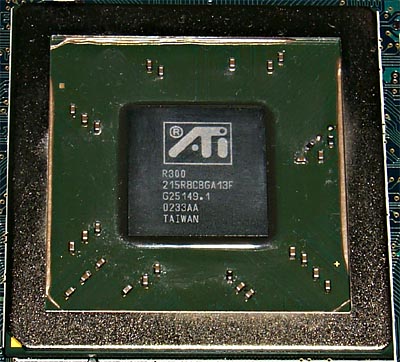 Well, if the chip had been cut off on the hardware level, they would have change the marking. This is one more evidence of turning the RADEON 9700 into the 9500 using some software tricks. So, what do we have?
The programmers at ATI are far not simple guys. They did their best to conceal the way of cutting the chip and the memory, and the protection isn't broken so far. However, at Rage3D they managed to find a way of cracking the BIOS of the RADEON 9500 PRO, thus allowing to overclock it. Reportedly, there is also a crack of the BIOS turning the RADEON 9700 into the RADEON 9700 PRO. The cooler is traditional for all RADEON 9700/9700 PRO/9500 cards from ATI - it is a big black heatsink with a fan in the middle. I'm going to give no more comments on the design of the card as all necessary information can be found in the previous reviews, including DVI and TV-out. OverclockingThe card doesn't overclock by default. Although the frequencies can be seen and the tweakers like PowerStrip or RivaTuner can change them, it doesn't help. Either the frequencies are brought back to the defaults when we start a 3D application or the system hangs. As I just mentioned, one way-out was found, for example, here. We will overclock the RADEON 9500 PRO next time when more new products of ATI will be examined. Test system and driversTestbed:
The test system was coupled with In the tests we used ATI's drivers 6.218. VSync was off in the drivers, texture compression was off in the applications. DirectX 8.1 was used. Texture detail level set to High Quality. For comparison we used results of the following video cards:
Drivers' settingsAll the settings are given in the reviews listed above. Test results
2D graphicsAs before, the cards based on the RADEON 9700/9700 Pro or 9500 have impeccable 2D quality! No complains. But! Remember that estimation of 2D quality can't be objective. It depends on quality of a sample, and a card/monitor tandem (you should pay special attention to quality of the monitor and the cable). 3D graphics, 3DMark2001 SE synthetic testsAll measurements in the 3D tests were carried out at 32-bit color depth. Fillrate 
 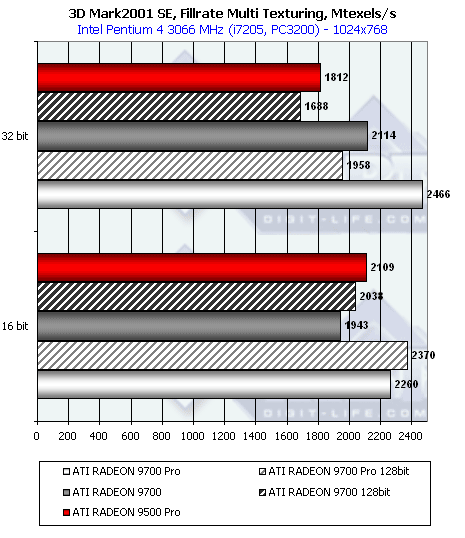
The RADEON 9500 PRO (8 pipelines) runs at the same speed in the single texture mode as the RADEON 9500 (4 pipelines). Moreover, at AA2x the RADEON 9500 PRO doesn't slow down at all, contrary to the GeForce4 Ti 4200-8x. The differences between the 9500 and 9500 PRO can be noticed only in this AA2x mode. At AA4x the RADEON 9500 PRO starts decreasing its speed, though the difference is still much smaller compared to the Ti 4200-8x. To find out the exact bit capacity we have carried out the following experiment. The chip contains the register RADEON_MEM_CNTL two bits in which enable/disable the memory controller. Let's see if we change its values:
So, we definiely has a 128bit bus. The hope of turning the 9500 PRO into the 9700 on the software level vanishes away. The 9500 and 9500 PRO have equal scores in the Fillrate test because of the limited throughput of the 128bit bus - it just can't record more than 4 32bit values per clock. To prove it we ran the Fillrate test in the 16bit mode. And now the difference between 4 pipelines of the RADEON 9500 and 8 pipelines of the RADEON 9500 PRO is noticeable. The 128bit bandwidth is sufficient for recording of eight 16bit color values per clock. And what about the performance drop in the 2õ MSAA mode? A 128bit bus wouldn't be enough for recording twice more values without losing the speed. The answer is that the R300, like NV30, supports the technology of color compression in the MSAA mode. This, in fact, is lossless compression, close to 2:1 - each pair of MSAA samples is compressed, and if they are identical (it happens almost always except edges of polygons which make a very small part) only one value is recorded. In the 2õ mode effectiveness of such compression will be equal to the NV30, but in the 4õ mode the drop is much greater - it seems that only pairs of samples can be compressed, - if there are 4 identical samples, the factor is not 4:1 like in case of the NV30, but remains 2:1. It results in a twice greater frame buffer in the MSAA 4õ mode. However that may be, but 2:1 is much better than nothing, and this is what we can see comparing performance of the RADEON and GeForce 4 in the MSAA mode. So, these two tests show that:
Scene with a large number of polygonsIn this test you should pay more attention to the minimal resolution where the fillrate makes almost no effect: 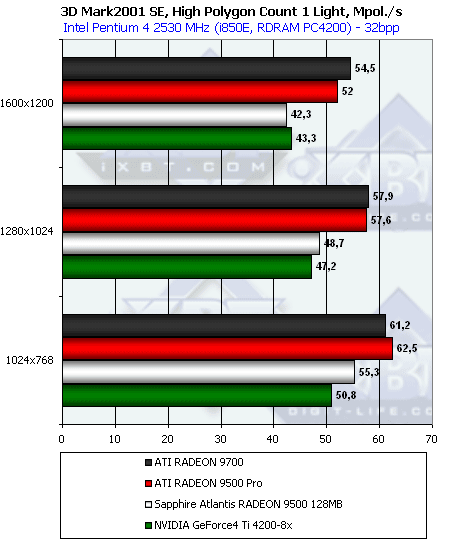
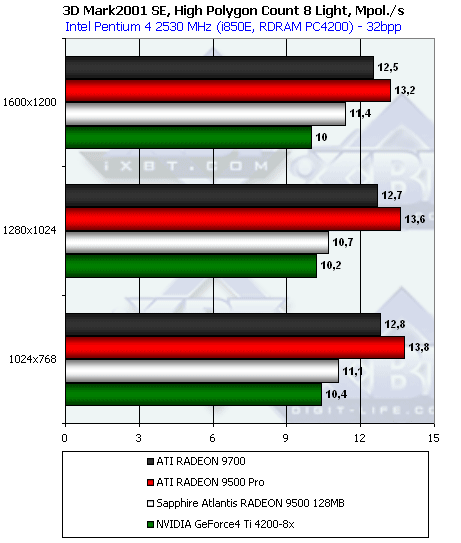 It's interesting that the developers overlooked the performance when lighting is enabled, and the RADEON 9500 PRO overtakes the RADEON 9700. According to ATI, they have identical chips, and it again proves that the card lost its weight on the software level, and the designers didn't account for all nuances. Bump mappingLook at the result of the synthetic EMBM scene: 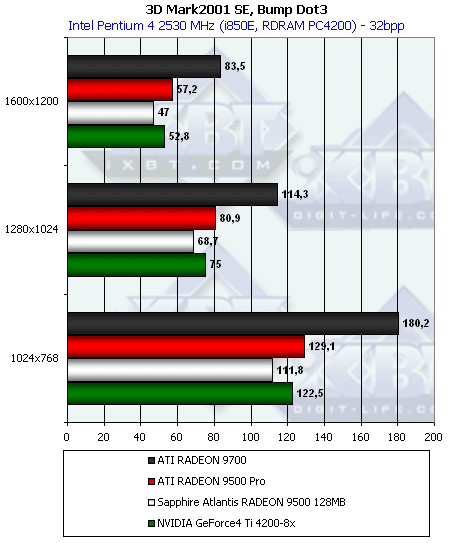 It's OK here. Note that the RADEON 9500 family processes the bump mapping faster than the Ti 4200. And now the DP3 relief:  Vertex shaders
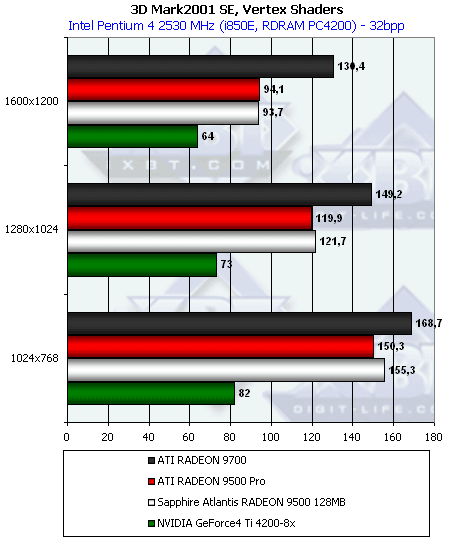 The RADEON 9500/PRO outstrips its rival from NVIDIA, which lets me think that none of 4 vertex pipelines of the 9500 and 9500 PRO were reduced but just smartly frozen relative to the RADEON 9700, or only a part of the pipelines is used for execution of shaders while the TCL emulation enables a full set of the units (see the geometrical performance test above). Pixel shader
The victory of the RADEON 9500 over the Ti 4200 is quite logical (4 pixel pipelines working at a higher clock speed), and the faster operation of the RADEON 9500 PRO makes me think that it has 8 texture units, not 8 pipelines. Sprites
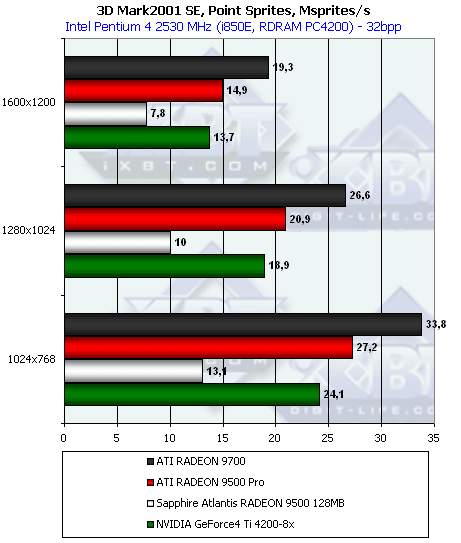 In closing of the synthetic part of the tests I can only repeat what I said after the fillrate test: the RADEON 9500 PRO has 8 pipelines with one texture unit on each, i.e. 8x1. Also, we proved that it's coupled only with two controllers and therefore 128bit hardware memory bus (though the virtual 256bits in AA are evident). Well, ATI is really smart - it modernized the PCB, made it cheaper and took in those who wanted to turn RADEON 9500 PRO into RADEON 9700. In the mode of execution of vertex shaders the chip is forcedly slowed down relative to the 9700, while in the fixed TCL mode its performance is not limited and equals the normal R300, which will definitely affect applications without vertex shaders. However, everyone is satisfied: ATI is not bothered with questions like how they dare make relatively cheap cards with a 256bit bus, NVIDIA doesn't giggle aside thinking that that it might be too good to provide 256 bits on a mainstream card. The protection works. 3D graphics, 3DMark2001 - game testsNote: The diagrams do not include the RADEON 9500 64MB due to some technical problems, but it was taken into the comparison tests, and this card can be found in the comparison table. But I think that such card shouldn't be priced over $100. 3DMark2001, 3DMARKS
 3DMark2001, Game1 Low details

 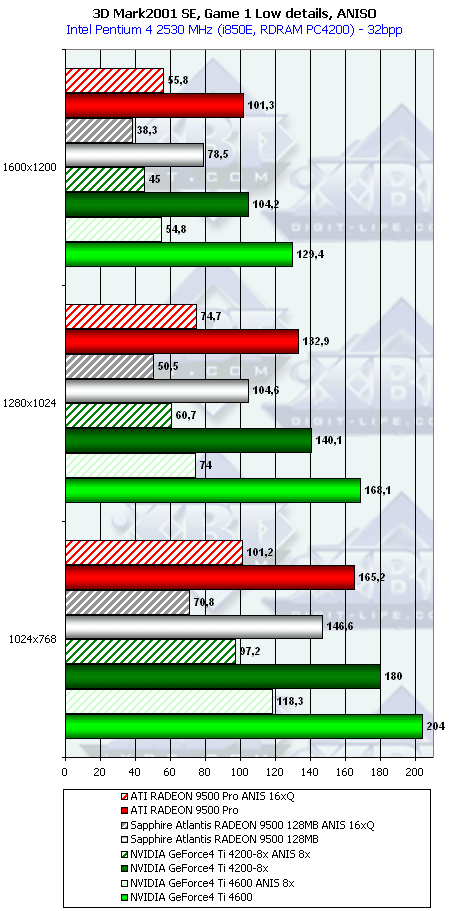
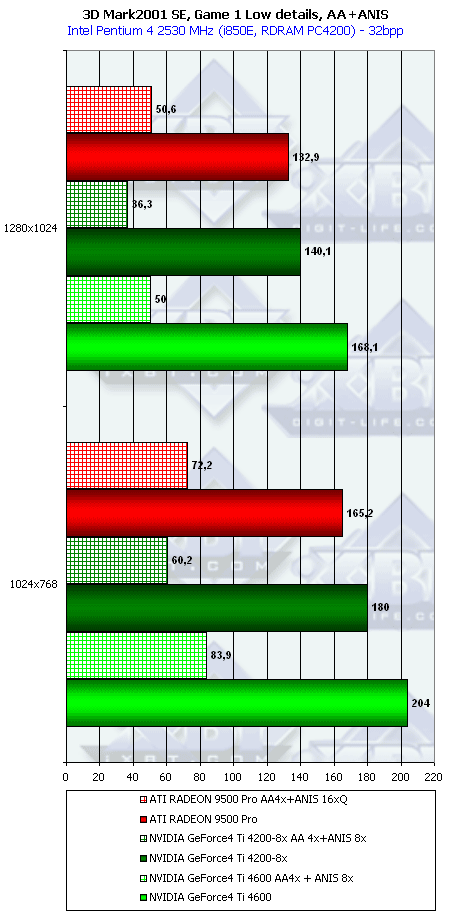 
3DMark2001, Game2 Low details

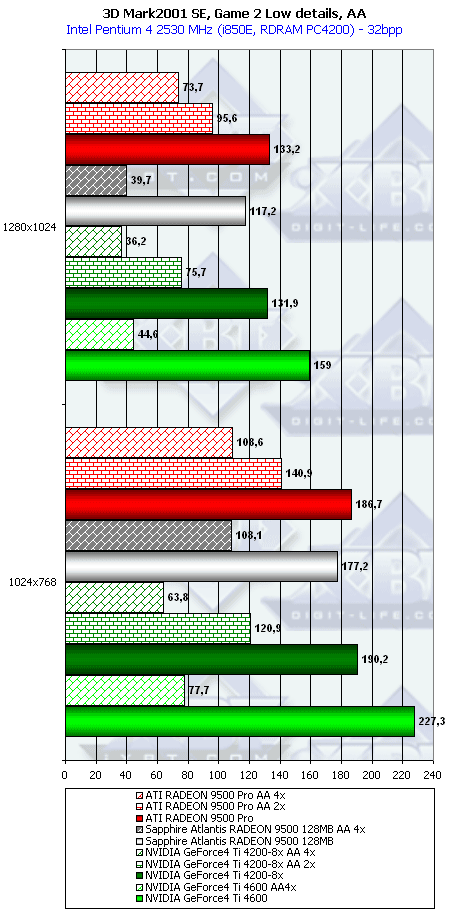 
 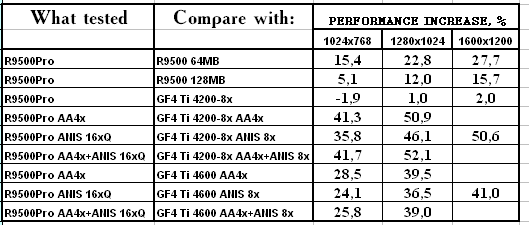
3DMark2001, Game3 Low details

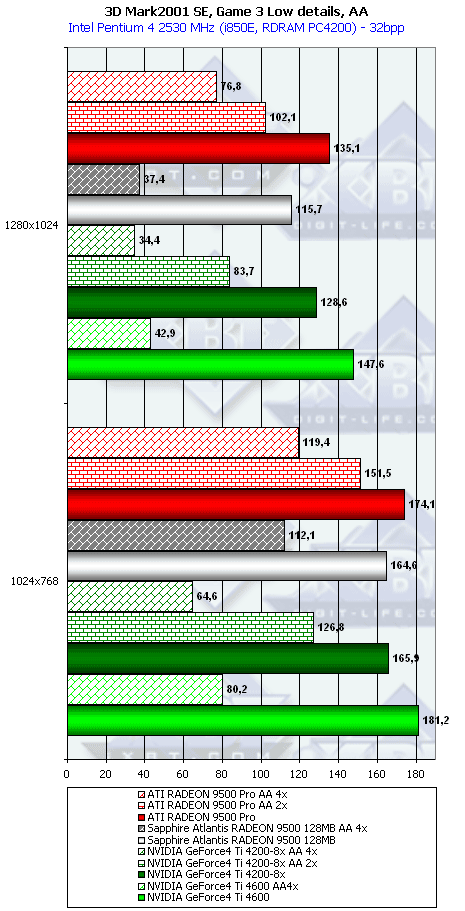 
 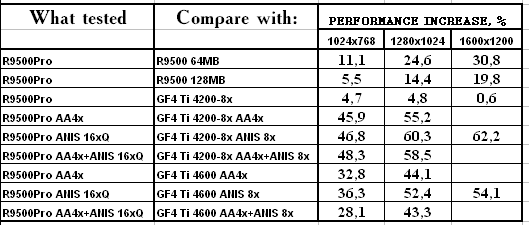
3DMark2001, Game4

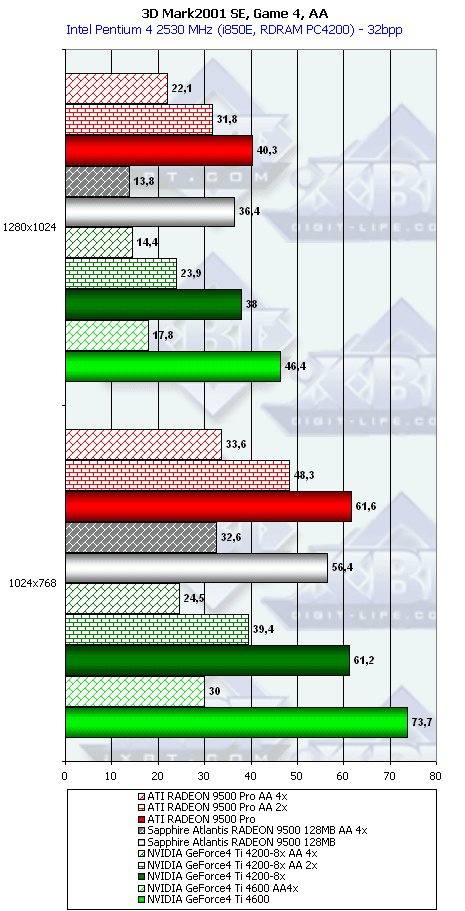 
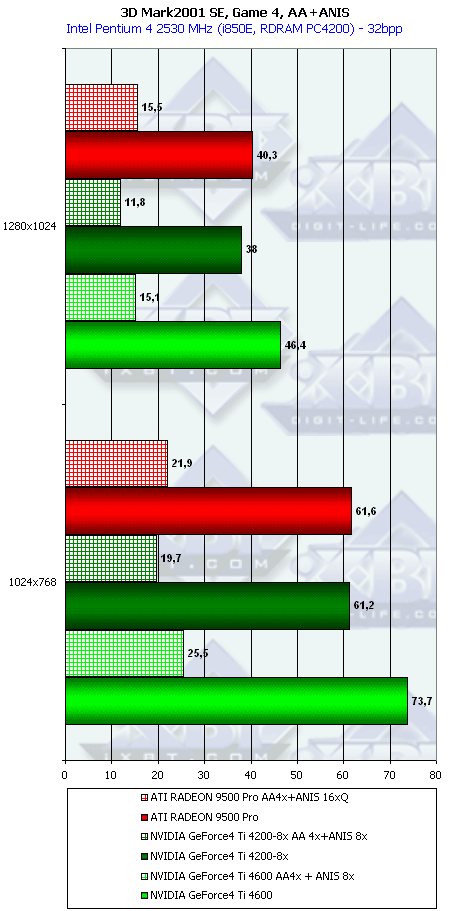 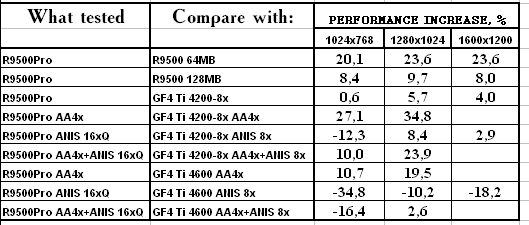 The RADEON 9500 PRO takes the position between the GeForce4 Ti 4200-8x and Ti 4600, and in the heavy modes it often outruns the Ti 4600. Isn't it excellent for $200? 3D graphics, game testsFor estimation of 3D performance in games we used the following tests:
Quake3 Arena, Quaver

 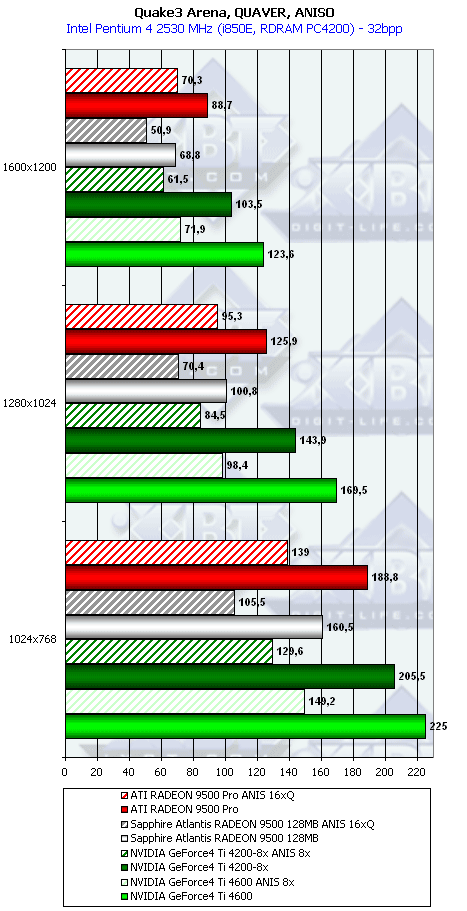
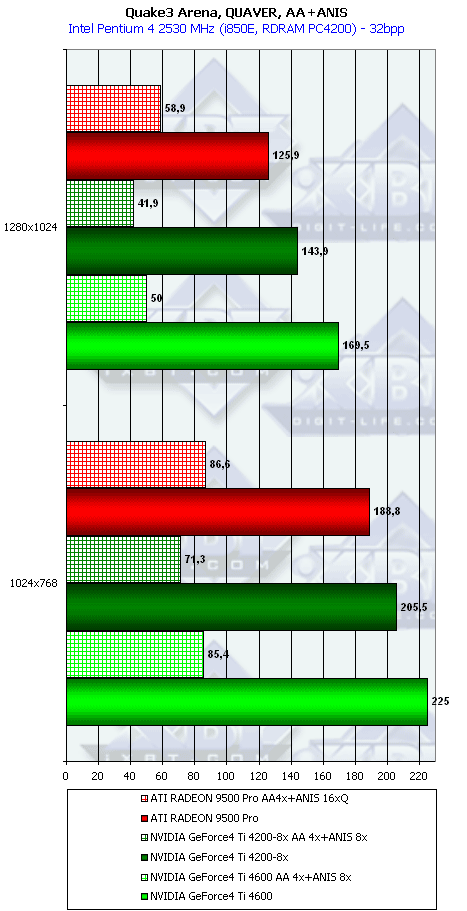 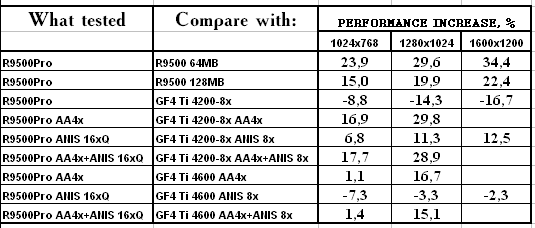 Serious Sam: The Second Encounter, Grand Cathedral

 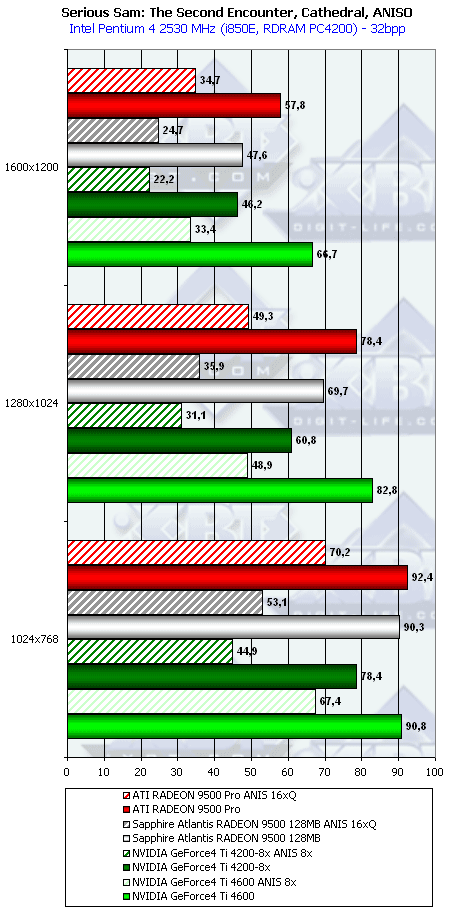
  Return to Castle Wolfenstein (Multiplayer), Checkpoint

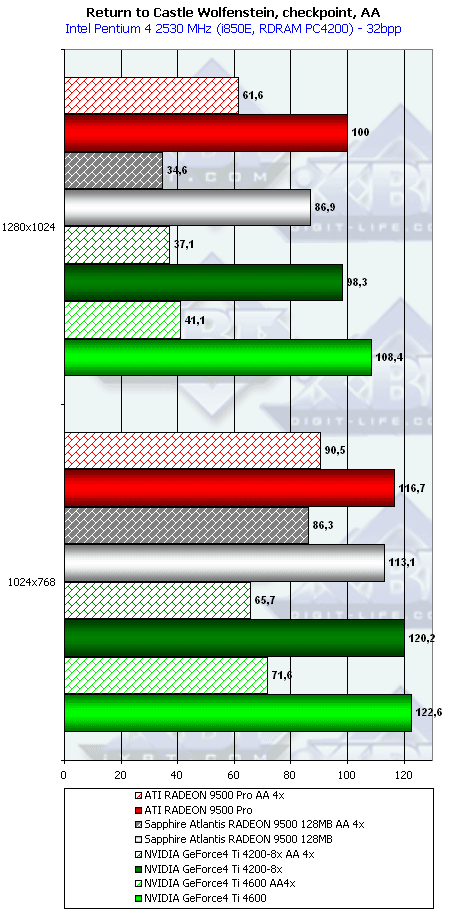 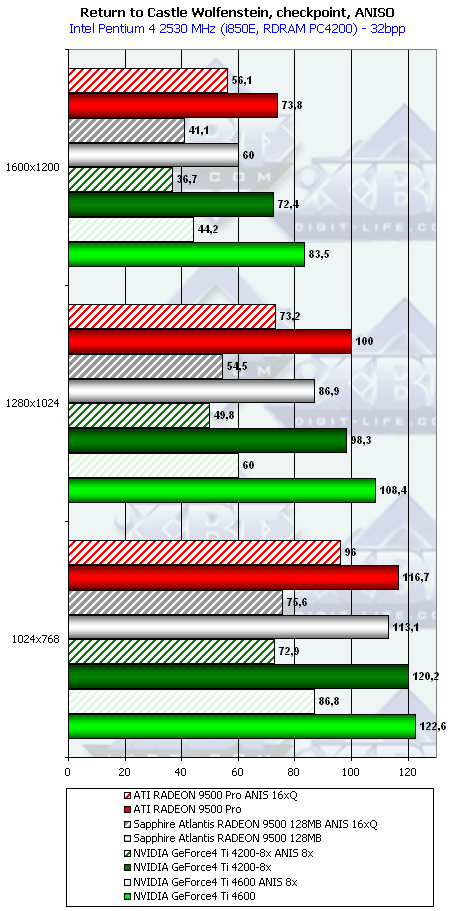
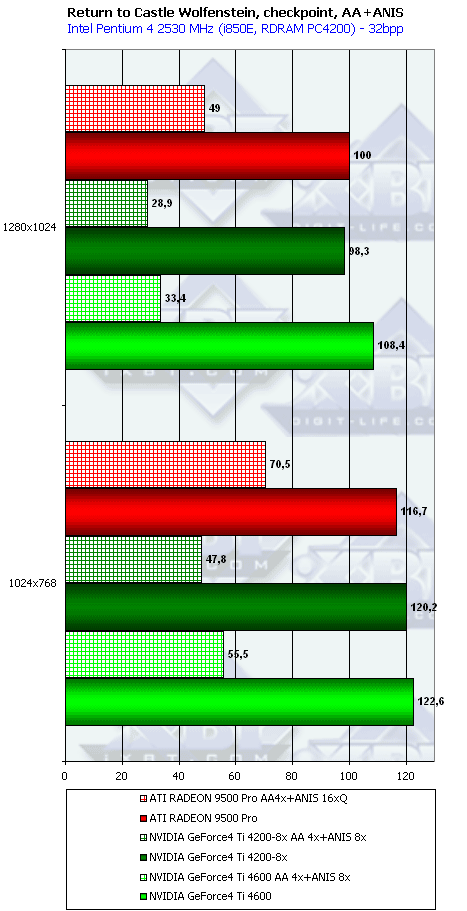  Comanche4 DEMO

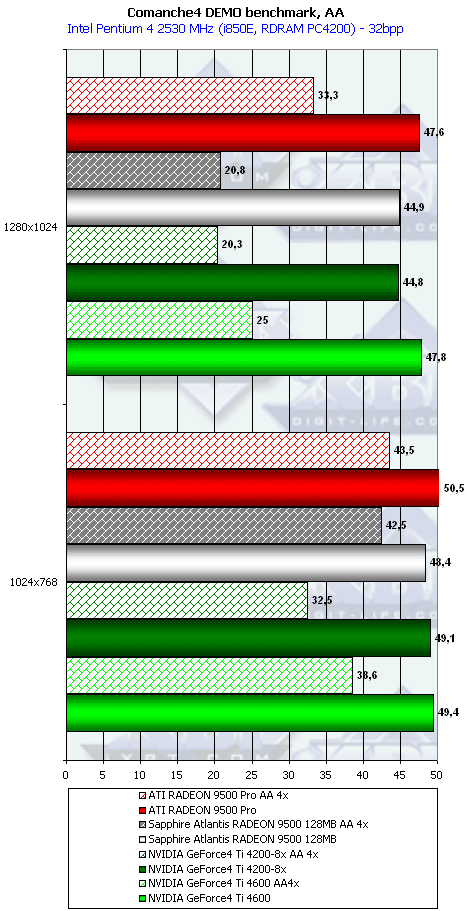 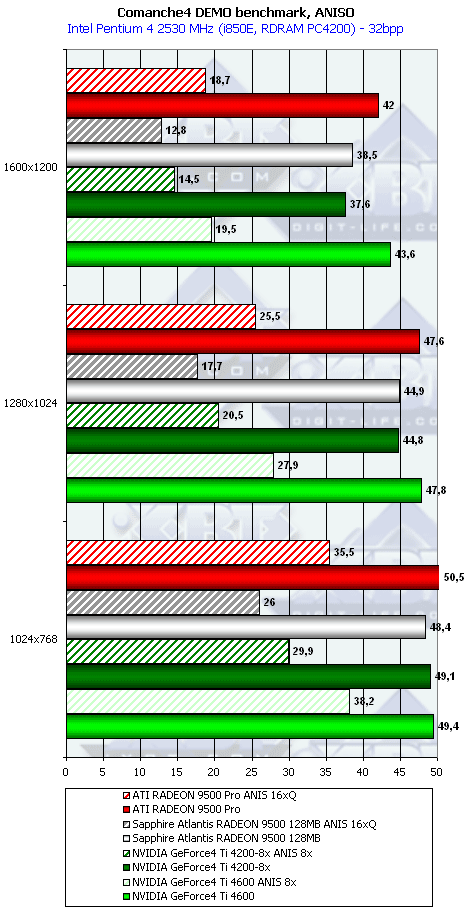
  Unreal Tournament 2003 DEMO

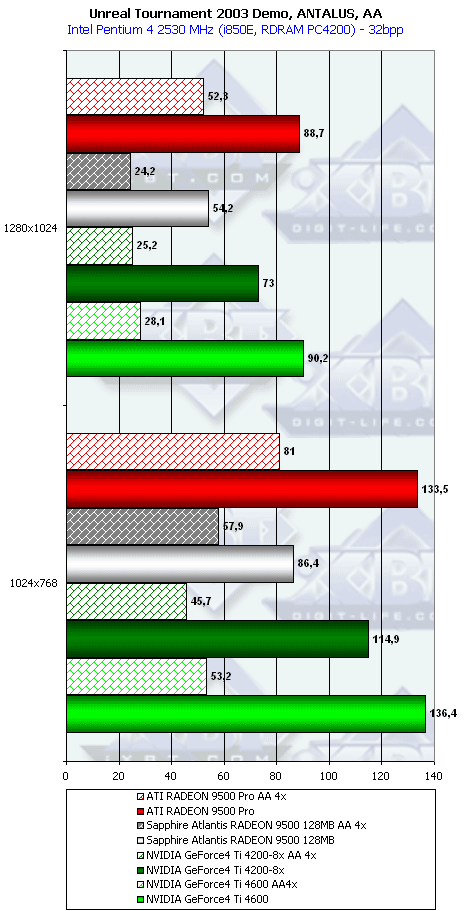 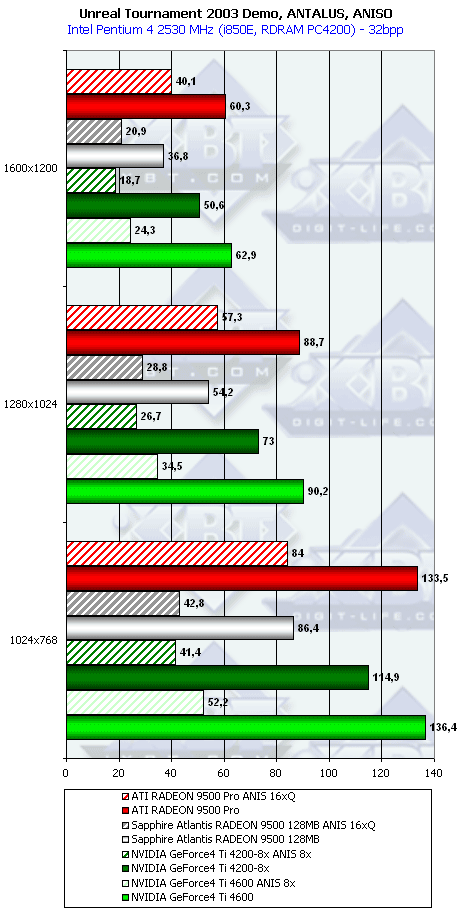
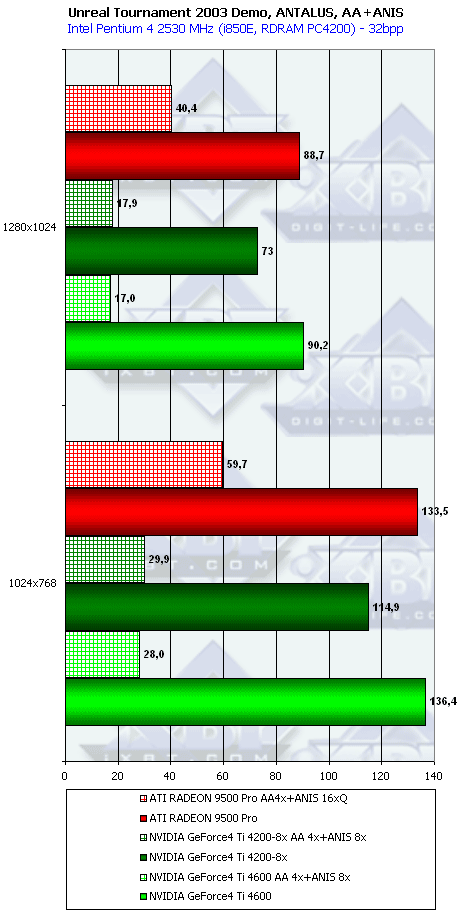  AquaMark
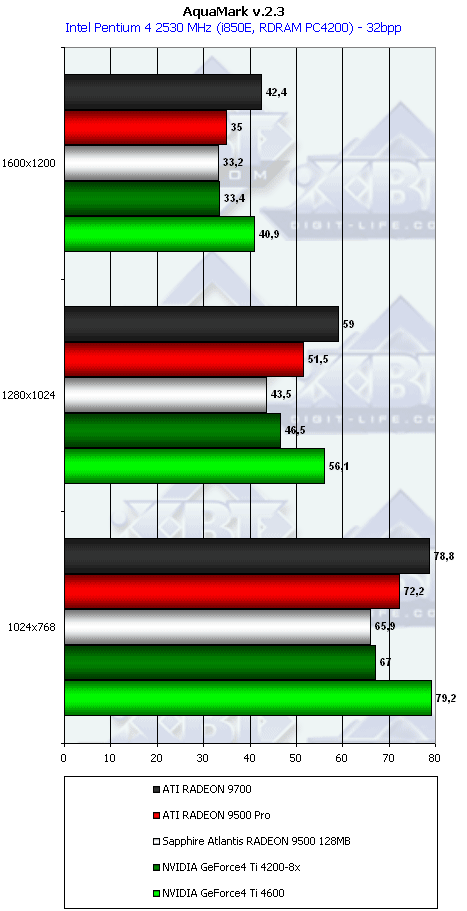
 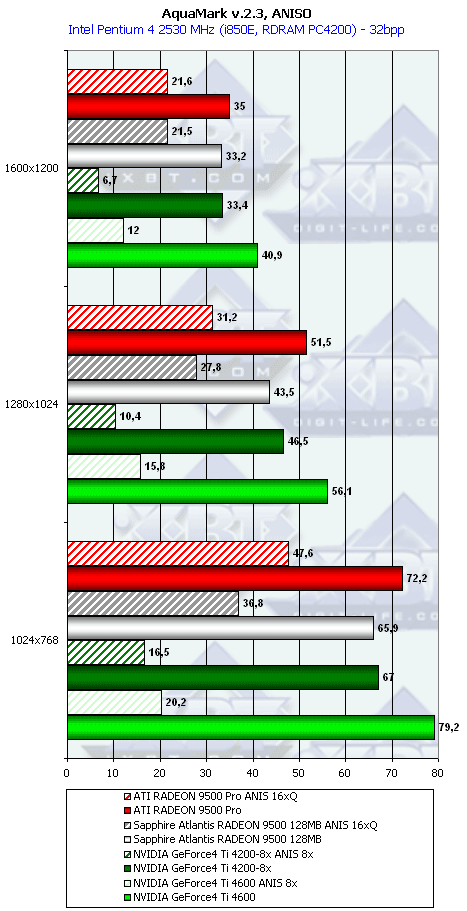
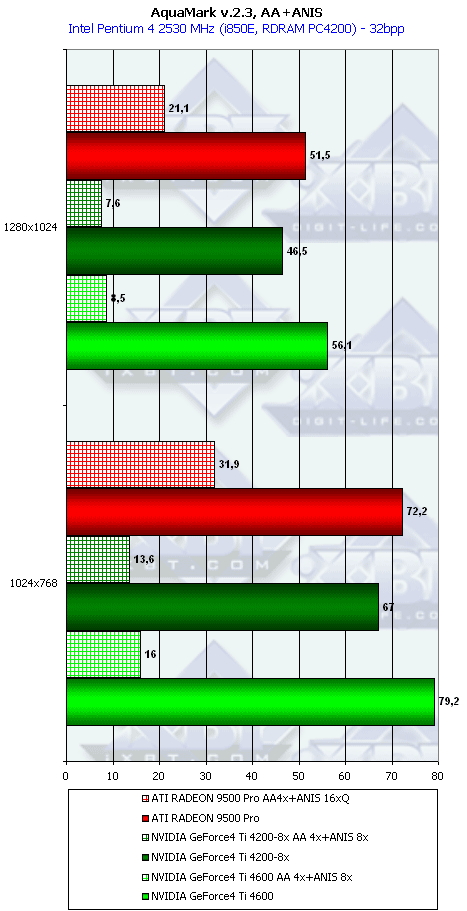 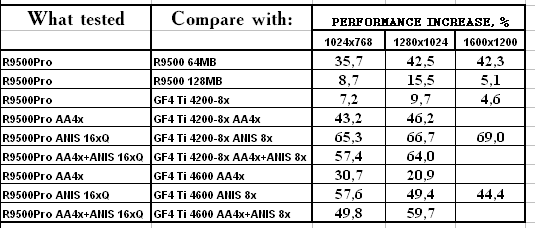 RightMark 3D
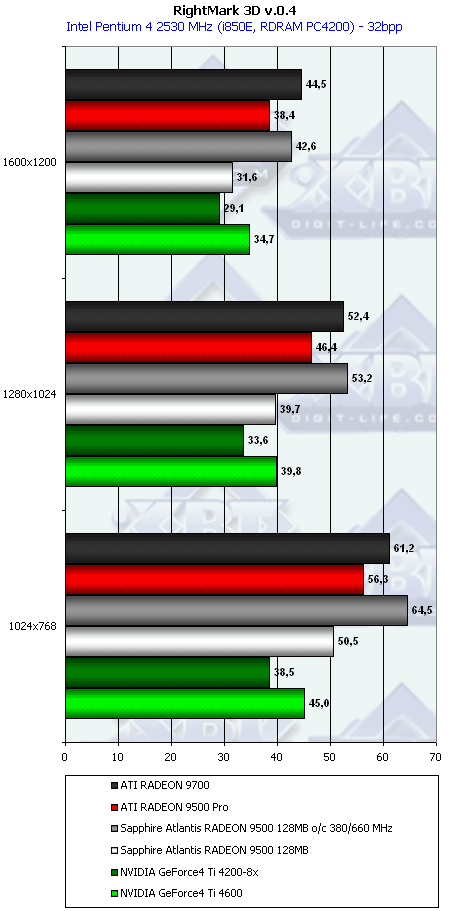
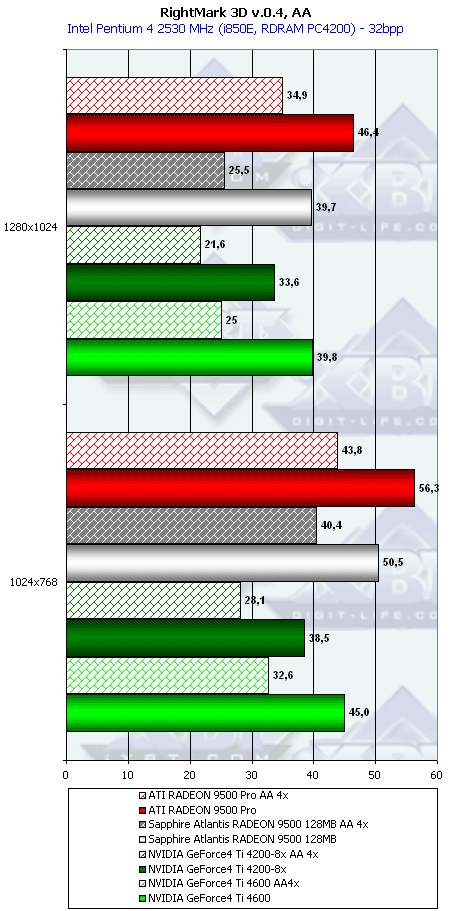 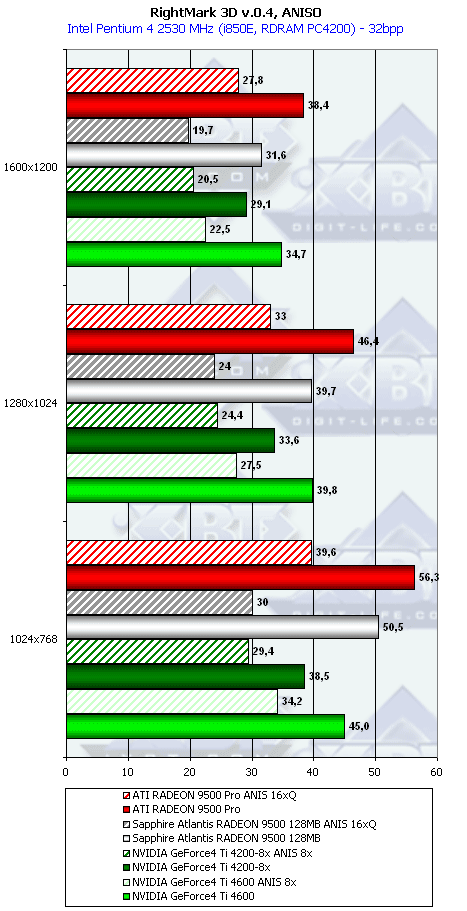
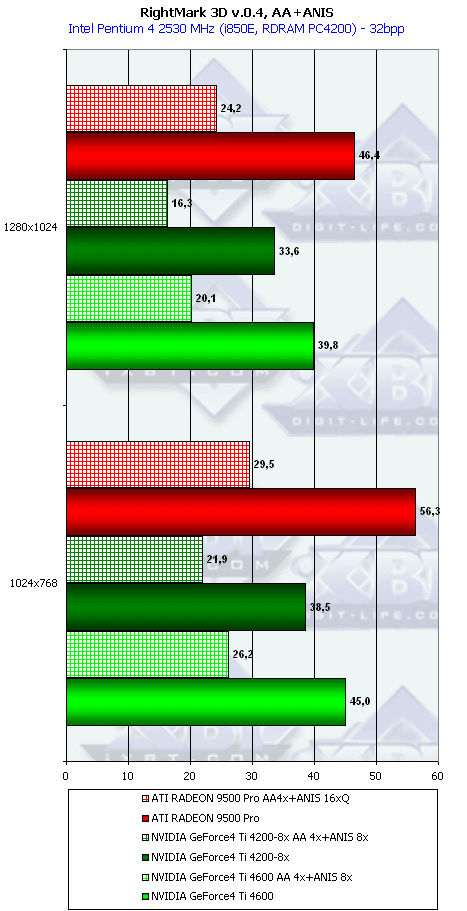 
The quality wasn't examined today as it's obvious that it doesn't differ from the RADEON 9700. If there are any changes, next time they will be taken a look at. Conclusion
I hope we will be able to overclock the card very soon, and 3Digest in January, 2003 will cover an overclocked sample as well, and we will publish one more review of the ATI's products with such cards. I hope that such attractive cards as RADEON 9500 PRO which are in short demand
now will soon hit much more stores. As for a competition with more advanced models
on the Ti 4200-8x, for example, ASUS V9280S, I must say that right now the prices
of the latter are still high, and taking into account that dealers prefer to maintain
prices for ASUS products at a high level, I think that the RADEON 9500 PRO will
be falling in price faster; and secondly, in the heavy modes the RADEON 9500 PRO
often outdoes the Ti 4600, not to mention the Ti 4200-8x at 275/600 MHz.
Andrey Vorobiev (anvakams@ixbt.com)
Write a comment below. No registration needed!
|
Platform · Video · Multimedia · Mobile · Other || About us & Privacy policy · Twitter · Facebook Copyright © Byrds Research & Publishing, Ltd., 1997–2011. All rights reserved. | |||||||||||||||||||||||||||||||||||||||||||||||||||||||||||